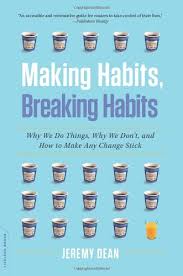In the Calm Clarity program, I explain the neuroscience behind how habits are formed and changed. The key to successfully achieving self-chosen goals is to align mental, emotional and behavioral habits and patterns to support the goals. Therefore, I teach the participants different meditations to enhance the parts of the brain associated with willpower and mindfulness and which support them to build habits and patterns that move them forward. So far, the realizations have been very powerful.
I just finished reading Jeremy Dean’s book: Making Habits, Breaking Habits: Why We Do Things, Why We Don’t, and How to Make Any Change Stick. Interestingly, what he writes overall aligns with the Calm Clarity program, though he doesn’t go into much detail on brain function.
The key ideas are captured in these excerpted paragraphs (given out of sequence):
“The strange thing about habits is that because we perform them unconsciously, we aren’t always aware exactly what they are. We might well be aware of the results of bad habits, such as being overweight, or continually missing deadlines, but how we got into the situation isn’t so clear. The very first step in breaking a habit is to get a handle on when, how, and where we are performing it. Some of our own habits are obvious to us, but many are not. It’s hard to change something until you know what it is in the first place. Other people may be able to provide clues (if you can bear asking), but one self-contained method to use is mindfulness.” (P. 152-153)
“Developing a good habit will be most successful when we do it for its own sake, when it’s done automatically, and when we take satisfaction in what we’ve achieved–even when it’s something as simple as a clean kitchen.” (P. 148)
“In theory, making habits should be easy. We do it automatically all the time. Think back to all the examples of everyday habits we seen earlier: traveling, eating, socializing, working, and shopping. These habits were established because we found ourselves in the same situations trying to satisfy our various needs and desires, and on returning to the same situation, we made the same choice again, and so on, repetition layered on top of repetition until the habit was built. Sooner or later, the behavior became unconscious and, whether useful or not, over time these habits took hold of sections of our lives. When making habits, we are trying to do something similar but with conscious planning. We start with a goal in mind to associate behaviors with situations, and what we are aiming for is their unconscious and automatic execution. Each repetition takes us one small step further up the curve of that graph.” (P. 149)
“The beauty of habits is that, as they develop, they become more effortless. Even when you’re tired, upset, or distracted, strong habits are likely to be performed because they’re so ingrained. Habits that you constructed yourself, for your own purposes, can seem like magic when they work. Like other behaviors that we carry out on a regular basis, the fruits of good habits may build up slowly, but they can repay the effort made to establish them many times over.” (P. 149)



One thought on “Master or slave of habit? With mindfulness you have a choice”